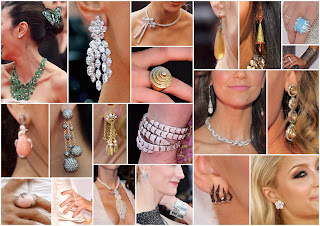Tuesday, December 9, 2014
Friday, October 24, 2014
Thursday, November 18, 2010
Saturday, October 16, 2010
Monday, April 5, 2010
Misleading Gemstone Names
Misleading Gemstone Names
Read jewelry ads and you'll see descriptive terms tacked-on to the names of gemstones, like Oriental emerald (it's really a green sapphire), American ruby (a garnet) and Australian jade (treated quartz).
Sometimes extra terms do describe the source or type of gem that's being advertised, but many are deceptive, and some sellers hope you won't notice that they replace what you think is a more expensive gem with either a look-alike gem that's less expensive or components made from glass and other materials.
There are hundreds and hundreds of examples of misleading gemstone names. Here are some of the most common.
Diamond Impostors
German diamond: quartz
Herkimer diamond: double-terminated quartz
Bohemian Diamond: quartz
Most of the stones advertised with diamond in the name, but with a qualifying term in front of the word, are quartz.
Emerald Impostors
African emerald: green fluorite
Bohemian emerald: green fluorspar
Broghton emerald: green glass
Chatham emerald: synthetic emerald
Cape emerald: Prehnite
Gilson emerald: synthetic emerald
Emeraldine: chalcedony that's dyed green
Oriental emerald: sapphire
Evening emerald: peridot
Spanish emerald: glass
Ruby Impostors
Adelaide ruby: Australian garnet
Australian ruby: garnet
Bohemian ruby: garnet
California ruby: garnet
Cape ruby: garnet
Montana ruby: garnet
San Diego ruby: red tourmaline
Siberian ruby: tourmaline
Sapphire Impostors
Brazilian sapphire: blue tourmaline
Burma sapphire: synthetic sapphire
Hope sapphire: synthetic blue spinel or lab grown sapphire
True sapphire is sometimes called descriptive names, like Kashmir sapphire, which is a deep blue version of the gem, but most of today's sellers use the stone's color as a descriptive label.
Jade Impostors
African jade: garnet
Colorado jade: feldspar
Honan jade: soapstone
Indian jade: aventurine
Manchurian jade: soapstone
Swiss jade: jasper
Pearl Impostors
Atlas pearls: calcite beads
Delta pearls: imitations
Roman pearls: glass beads
Swarovski pearls: glass beads
Opal Impostors
Ceylon opal: moonstone
Blue opal: lazulite
Lapis Impostors
Swiss lapis: chalcedony or dyed jasper
German lapis: dyed jasper
Canadian lapis: sodalite
Turquoise Impostors
African turquoise: jasper
Chinese turquoise: calcite, soapstone
Sacred turquoise: smithsonite
Utah turquoise: variscite
Vienna turquoise: simulated at one time but may contain reconstituted turquoise
Yellow turquoise: often jasper or serpentine
Amazonite and chrysocolla are two gemstones that resemble turquoise and are sometimes confused with it.
The jewelry made from "impostor" gems might be just what you're looking for, so don't hesitate to buy it, but do some homework before you make a purchase so that you understand exactly what you are buying.








